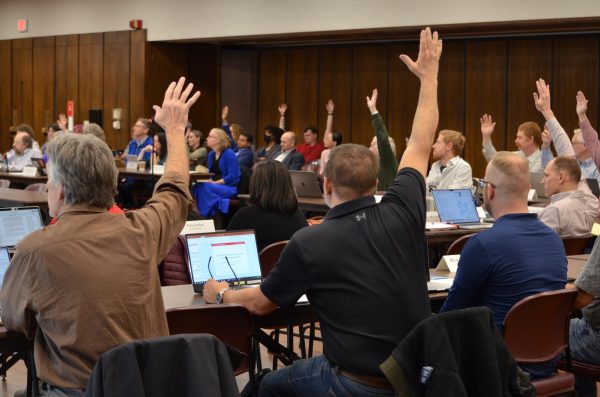Local option sales tax legislation could result in revenue loss for local government
Sens. Jesse Green, Herman Quirmbach and Rep. Beth Wessel-Kroschell at the Legislative Update hosted by the Ames Chamber of Commerce.
Local officials questioned legislators on the impact of revenue for municipalities as the state looks to potentially repeal local option sales and services taxes.
Story County Supervisor Linda Murken said these changes to the local option sales tax could result in a loss of over $233.8 million by 2029, according to the Legislative Services Agency fiscal note of Senate File 550.
“It’s getting really difficult to determine how we are going to keep things going,” Murken said at the Legislative Updated hosted by the Ames Chamber of Commerce.
Impacts on local government include allocating state sales tax revenue to cities and counties and phasing out the property tax credit funded by the state.
The property tax credits would then be replaced by a property tax exemption that would lower the property tax base for local governments.
“For these types of situations, the revenue reductions projected for the homestead and military service exemption as well as the business rollbacks are more of a tax shift to all property taxpayers and less of an actual revenue reduction for local governments,” according to the fiscal note from the bill.
Murken said the bill still grants the homestead and military exemption, but there will not be state money to pay for them resulting in a financial loss for local governments, questioning how local governments are supposed to continue providing services with the loss of revenue.
State Sen. Jesse Green of District 24, a Republican, said local governments are sitting on reserves to cover expenses. State Sen. Herman Quirmbach of District 25, a Democrat, said reserves is another word for one-time funds.
A community member present questioned how these projects continue to progress when the one-time federal funds are gone for the state.
“The difference between what we’re doing and what other states have done like Kansas […] is we have budgeted responsibly,” Green said.
Green said Iowa now has a $1 billion cash reserve and $1.7 billion in emergency funds, and that surplus is projected to grow to $2.7 billion by 2024.
“So we will continue to make sure that nothing gets dropped as the COVID dollars run out,” Green said.
Quirmbach said Republicans are using one-time funds to pay for their tax cuts, but tax cuts are an ongoing obligation.
“For years and years, I have heard Republicans lecture that you can’t pay for ongoing programs with one-time dollars,” Quirmbach said. “And you know what, they have been right about that […] it just seems that now that doesn’t apply when your ongoing program is a tax cut,”
When the income tax rates are lowered, Quirmbach said the Republicans will use the surplus to cover any shortfalls, but the money will run out eventually.
“Of the $2 billion of the so-called surplus this year, three-quarters of that comes from shortchanging education over the last six years,” Quirmbach said, “[…] I don’t know how we get out of this without having a real fiscal calamity.”
State Rep. Beth Wessel-Kroeschell of District 39, a Democrat, said there is $3 million in taxpayer relief, and it is time the state actually returns those dollars to the taxpayers by spending it on improving roads and education.
“We do have a significant amount of your tax dollars sitting in our account right now,” Wessel-Kroeschell said. “In many ways, I think we should all be pretty disturbed about that, especially since we have not been funding your priorities.”
Property taxes are based on the assessed value of a house. If the assessment appears inaccurate, then the house owner can file an appeal. Just over half the assessed value is taxed. The tax rate is based on the levy rate, in which schools, cities and counties receive the bulk for operational expenses.
Each of those taxing entities charges a certain percentage of the taxable evaluation. Quirmbach said the rollback that would apply to future taxes could go down to 46%, but it is still unclear what the taxable value will be. Quirmbach said when the tax base is growing faster than the taxing entities need for revenue, then the levy rate should be lower.
“To see what’s going to happen with your tax bill, that’s still a question that is in process,” Quirmbach said. “Talk to you local officials; property tax is a local tax. If you don’t think it’s appropriate to suspend anymore, tell them that they need to reduce the levy rate to offset the increase in the assessed valuation.”
When the tax rate goes up, the county and cities look at how much they need to function. Schools have a uniform levy rate, which is $5.40 per $1000 of table valuation. This rate is set by the state’s education formulas. Paying for K12 education is a combination of state aid and property tax.
Green said the state ranks 40th in the nation for property taxes, and to him that is unacceptable. The state House and Senate have differing bills on how to reform Iowa’s property tax.
Restructuring of state agencies
Republican Gov. Kim Reynolds also proposed legislation to restructure the state government, combining 37 executive-level cabinet agencies into 16, according to the Iowa Capital Dispatch. Dispatch also reported that Reynolds used pandemic relief funds to pay for consulting from an out-of-state company for the plan.
Wessel-Kroeschell said the 1,500-page plan did not receive a thorough analysis. In 2022, the Department of Public Health and the Department of Human Services were combined into one entity. Wessel-Kroeschell said while the director of the Department of Health and Human Services is a talented administrator, the department is now huge.
“There were problems with DHS in the beginning,” Wessel-Kroeschell said. “I am not sure putting more under one roof is the answer to solving our problems, especially without thorough analysis.”
As a general principle, Quirmbach said a review of departments is appropriate, but he does not think this review incorporated enough public involvement to properly meet the needs of the public.
“You should have been doing this over at least a five-year, maybe 10-year period,” Quirmbach said. “Instead, it is all being jammed through at once. There’s a lot more power concentrated in the governor’s office, that’s for sure, and a lot of people think that is the main point of it [the restructure].”
Green said if the federal government can function with 13 cabinets, then the state can operate with 16 directors.
“This didn’t just happen overnight, there was a lot of work during the offseason to make sure this realignment is going to save the taxpayers $200 million,” Green said. “So I am really proud of the governor on this.”
Your donation will support the student journalists of the Iowa State Daily. Your contribution will allow us to purchase equipment, send our student journalists to conferences and off-set their cost of living so they can continue to do best-in-the-nation work at the Iowa State Daily.













